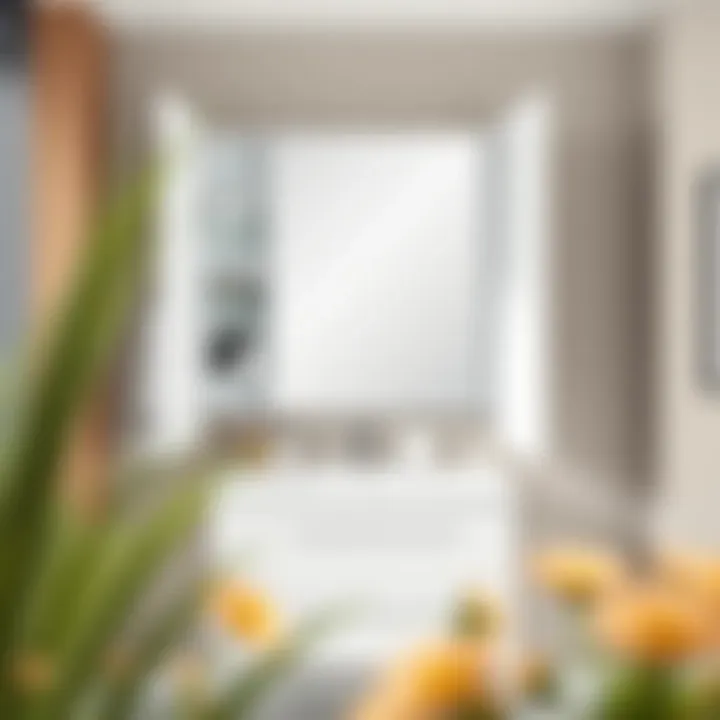The Optimal Medicine Cabinet: Design and Dimensions Guide


Intro
A well-thought-out medicine cabinet doesn’t just offer storage; it also elevates the entire bathroom experience. One might think about tossing in a few bottles of medicine and calling it a day, but there’s a world of design possibilities when it comes to this often-overlooked element of home decor. Moreover, the dimensions of a cabinet, specifically 15 by 25 inches, cater to both function and aesthetics, balancing storage needs with a sleek visual appeal.
In this piece, we will explore everything from the design intricacies of various styles to clever organization methods, all while focusing on how these elements can genuinely transform your bathroom. Whether you are a designer, a retailer, or a DIY enthusiast, there’s something here for everyone.
Furniture Design Insights
Understanding Style Preferences
Today’s medicine cabinets come in a plethora of styles, catering to a diverse range of tastes. Are you leaning towards a modern, minimalist vibe with clean lines and smooth surfaces? Or perhaps a more rustic wooden cabinet fits the bill, echoing warmth and a cozy atmosphere? Understanding these style preferences is vital as they inform not only the look but also the materials and functionalities that will best serve your needs.
- Contemporary Designs: Think sleek glass doors, polished chrome handles, and a vivid play of colors. These designs often feature open shelving within to display aesthetically pleasing items.
- Traditional Options: Here, wooden finishes in rich tones like mahogany or oak take center stage. They often incorporate intricate moldings and vintage knobs, offering a nod to classic design.
- Eclectic Mix: For those who embrace uniqueness, combining old and new can produce a charming mishmash that reflects personal history and creativity.
Whichever route you choose, ensure that the cabinet complements other bathroom fixtures and your overall home aesthetic. It’s all about creating a harmonious flow.
Maximizing Space with Smart Layouts
Having a cabinet that fits proportionately within your bathroom layout is essential. A 15 x 25-inch cabinet strikes a balance; it’s spacious enough to house essentials yet compact enough to fit in tighter spaces. When mapping out your cabinet placement, consider these tips:
- Eye Level Access: Install the cabinet at a height that makes for easy visibility and reach. This placement ensures you don’t have to bend or stretch awkwardly to grab what you need.
- Over-the-Toilet Storage: Utilizing vertical space above the toilet can be a game-changer. Cabinets placed here often serve dual purposes, combining style and optimum storage without encroaching on floor space.
- Corner Cabinets: In bathrooms with limited wall area, a corner cabinet can maximize storage while looking sleek and unobtrusive.
"Good design is about making things simple yet functional, allowing for a seamless blend of style and usability."
With smart layouts, you can really make the most of what you have. Encouraging efficient use of space greatly aids in keeping necessary items organized and within arm’s reach.
Maintenance and Care Tips
Cleaning Techniques for Different Materials
A medicine cabinet can endure a lot, from splashes to spills. To preserve your cabinet’s allure and functionality, it’s vital to know how to care for it based on its materials:
- Glass and Mirrors: Use a mixture of vinegar and water, or a store-bought glass cleaner for a streak-free shine. Avoid abrasive pads to prevent scratches.
- Wooden Cabinets: Mild soap and water with a soft cloth work best. Afterward, a wood polish can help maintain the finish and prevent moisture damage.
- Metal Options: Wipe down with a damp cloth and a desired cleaner, but steer clear of harsh chemicals that may cause corrosion.
Preventative Measures Against Wear and Tear
To keep your cabinet looking pristine for years, consider adopting specific preventative measures:
- Regular Inspection: Routinely check hinges and surfaces for early signs of wear. This practice can help catch issues before they escalate.
- Avoid Overloading: While your cabinet might be spacious, cramming it full can lead to strain on hinges and shelves. Stick to a sensible storage approach.
- Humidity Control: In the humid bathroom environment, periodic airing can help reduce moisture buildup within the cabinet.
Taking these steps ensures your medicine cabinet remains both a functional and appealing feature of your home.
In the fast-paced world, where aesthetics and function collide, a well-designed medicine cabinet can improve your daily routine while marrying safety and style. As trends continue to shift, staying informed will enable you to make savvy design choices that extend beyond the mere act of storing. Discover the full potential of your space with insights that make a difference.
Understanding the Medicine Cabinet
The medicine cabinet, often taken for granted, serves a fundamental role in household organization and personal health. It's more than just a small storage space for band-aids and aspirin; it’s a vital component of home first aid preparedness and wellness routine. This article aims to illuminate the nuances of these cabinets, particularly focusing on the widely accepted dimensions of 15 x 25 inches.
Why is this topic worthy of discussion? Well, every home deserves a well-thought-out space to store not only medication but also health essentials, sanitation products, and sometimes even beauty items. The design and dimensions influence not just aesthetics but practicality as well.
Ultimately, understanding the medicine cabinet isn't merely about its physical dimensions; it encompasses its history, materials, placement, and more. This comprehensive grasp reveals how a simple cabinet can elevate a space's functionality, transforming it into a vital resource for health and safety.
Historical Context
The concept of a medicine cabinet is a bit of a throwback, with roots tracing back centuries. Early civilizations recognized the need for organized storage of medicinal herbs, tinctures, and tools. In ancient Egypt, one could find small compartments carved into stone walls where health aids were neatly arranged, although that might have looked a tad different from your typical modern-day cabinet.
Fast forward to the Renaissance, when advancements in both medicine and cabinetry became evident. Medicine was evolving, and so were the methods of its storage. By the late 19th century, the introduction of the wall-mounted cabinet became prevalent in homes, often adorned with intricate woodwork to contribute to décor as well as utility.
Recognizing this historical evolution sheds light on how we arrived at contemporary designs. Today’s beautifully minimalistic or rustic-style medicine cabinets still echo themes from our forebearers, blending tradition with modern design sensibilities.


Common Materials
What materials we choose play a critical role in the cabinet's longevity and overall appeal. Most modern medicine cabinets are typically composed of a few key materials:
- Wood: Often seen in traditional or rustic designs, wood cabinets can convey warmth and timelessness, making them ideal for a cozy bathroom setting.
- Metal: Stainless steel has surged in popularity due to its durability and modern vibe, appealing particularly to those interested in industrial aesthetics or contemporary bathrooms.
- Glass: Used for doors or decorative elements, glass provides an airy feel while allowing for visibility of the items inside, potentially becoming a stylish focal point.
- MDF (Medium-Density Fiberboard): A cost-effective alternative to hardwood, MDF can be painted and finished to mimic more expensive woods, making it an attractive option for budget-conscious homeowners.
Incorporating these materials aligns with not just appearance but also practicality. For instance, moisture-resistant materials are essential in bathrooms where humidity reigns. Ultimately, the right choice enhances both durability and the personality of the cabinet, offering a balanced intersection of form and function.
"The right material choice can elevate a cabinet from merely functional to a centerpiece of design and utility."
By understanding the significance of the cabinet’s history and our material options, homeowners and designers alike can make intentional choices that reflect not only practical needs but also personal style.
Significance of Measurements
In the world of interior design, measurements often hold the keys to transforming a space from mundane to functional. When considering a medicine cabinet, understanding its dimensions is paramount. Crafting the perfect cabinet isn't just about aesthetics — it's about fitting a well-designed piece into the available space while ensuring it meets various needs. In this article, we will dive into the measurements of the ideal medicine cabinet and assess how they impact its utility and visual appeal.
Standard Dimensions Explained
The standard dimensions for medicine cabinets serve as a guide for designers and homeowners alike. These sizes, typically falling within the range of 15 inches wide by 25 inches tall, are not arbitrary. They strike a balance between compactness and functionality. A cabinet that is too small may not fit necessary items, while one that is overly large could dominate the room and detract from the overall design.
Here are some key points regarding standard dimensions:
- Height and Width: The 15 x 25 standard provides ample vertical and horizontal space for essential items.
- Depth Consideration: Usually ranging from 4 to 6 inches, depth is critical for storage without protruding excessively into the space.
- Compatibility: These dimensions often complement standard wall spacing, reducing the risk of installation issues.
Understanding these parameters enables better planning, ensuring the cabinet will not only look good but also perform well in daily use.
The x Dimensions
Why focus on 15 x 25 dimensions? This specific size caters well to average bathroom configurations. Not too obtrusive yet spacious enough, it brings both utility and elegance.
- Storage Efficiency: This cabinet size typically allows for the inclusion of multiple shelves, providing various compartments for different items such as medication, first-aid supplies, and grooming essentials.
- Easy Access: With a 15-inch width, retrieving items becomes a breeze. Users do not have to struggle to reach or find what they need.
- Design Versatility: The 15 x 25 dimensions can fit harmoniously within different bathroom layouts and styles, from modern minimalist to classic vintage.
In essence, the popularity of this measurement can boiled down to its balance of function and form, making it an ideal choice for countless settings.
Why Size Matters
When it comes to medicine cabinets, size matters for more than just aesthetics. Here’s why the right dimensions can play a crucial role in a successful design:
- Space Optimization: A properly sized cabinet maximizes wall space efficiency. This means more room is available for other essentials, ensuring everything within a bathroom remains well-organized, avoiding a cluttered appearance.
- User Comfort: Consider the height of the cabinet — it should be positioned where the average user can comfortably access its contents without straining.
- Design Cohesion: The size of a medicine cabinet can either enhance or overshadow other elements in the bathroom. A cabinet that is too large can overpower the design, while a smaller piece might get lost in the surrounding décor.
Ultimately, size impacts not only how a cabinet looks but also how well it functions in daily life. Selecting dimensions that fit the unique characteristics of a space allows homeowners and designers to create a solution that is both pleasing to the eye and practical.
"The right size medicine cabinet can make all the difference in how a bathroom feels — functional, organized, and aesthetically pleasing."
By paying attention to these details, individuals can ensure that their medicine cabinet seamlessly joins the design narrative of their space while standing as a functional component in their daily routine.
Design Considerations
Design considerations play a crucial role in the effectiveness and appeal of a medicine cabinet. The right design not only houses essential items like medications and first-aid supplies but also blends seamlessly with the surrounding environment. Homeowners and designers alike should prioritize aesthetics, functionality, and material choices to create a cabinet that meets practical needs while enhancing the overall style of the space.
Aesthetic Elements
A medicine cabinet should not be a mere afterthought in bathroom design; rather, it ought to be a focal point. How it looks can set the tone for the entire room. The cabinet's finish, colors, and hardware selection can complement or contrast with other fixtures. For instance, a sleek, chrome handle may suit a modern space, while a rustic wooden knob could enhance a farmhouse aesthetic.
Additionally, consider the style of the cabinet door itself. Sliding doors offer a minimalist look, while framed mirrors add elegance and functionality. Using glass shelves inside can also elevate an otherwise ordinary cabinet. It’s about striking that balance between what’s pleasing to the eye and what feeds the room’s vibe.
"A good design isn’t just about how it looks; it's about how it works together with its environment."
Incorporating lighting can also elevate the aesthetic appeal. Soft, integrated lights not only provide visibility but create an inviting atmosphere. Mirrors, too, can help amplify light and space, making a small bathroom feel larger and brighter.


Functional Design
While looks matter, functionality is paramount in a medicine cabinet. Space maximization is essential, especially in smaller bathrooms. Clever layouts with adjustable shelving can adapt to various items, be it tall bottles of shampoo or small first aid kits.
Create a layout that considers the frequency of use. Regularly used items should be easily accessible, perhaps in the central section of the cabinet, while less commonly needed supplies can be stored higher or lower. Also, incorporating pull-out trays or bins can help keep things organized and ensure every item has its place.
Additionally, ventilation is a must-have feature that many forget. Keeping items cool and dry can extend their shelf life and maintain their efficacy, especially for products sensitive to heat and humidity.
Material Choices and Their Impact
What materials you choose for your cabinet has a major impact on its durability and overall appeal. For instance, moisture-resistant materials are a no-brainer for bathroom settings. MDF coated with a waterproof laminate can provide robustness without breaking the bank, whereas solid wood offers timeless appeal but must be maintained to avoid warping.
Glass shelves are a popular choice not just for aesthetics but also for their easy cleaning. On the flip side, plastic organizers can provide an economical solution for smaller segments in the cabinet but might lack longevity.
Think of sustainability, too. Choosing materials that are eco-friendly can add to the value of your home and appeal to environmentally-conscious buyers. Bamboo, reclaimed wood, and recycled materials are all great choices that don’t sacrifice style over sustainability.
Location and Installation
The location and installation of a medicine cabinet are crucial for making the most of both space and functionality in a home. A medicine cabinet is more than just a storage unit; it's a staple wall feature that can enhance the usability and flow of a bathroom or any other designated area. When considering the optimal position, one must take into account how often the cabinet will be used and the space available around it.
Optimal Placement within the Home
Finding the right spot for your medicine cabinet can often be a measure of convenience over aesthetics. Generally, the bathroom is the most popular choice due to proximity to toiletries and other health-related items. However, there are alternatives worth considering:
- Bathroom Hub: Placing it near the sink allows easy access during morning routines.
- Bedroom Utilization: If space permits, a bedroom is another option for storing personal care items, especially if you prefer a dedicated functional area.
- Hallway Convenience: For family settings, having a cabinet in a hallway may cater to quick needs without the need for entering any specific rooms.
Consider the type of items you’ll store. If your medicine cabinet's primary function is holding everyday essentials, close proximity to where these items are frequently used is ideal.
Installation Techniques
Installing a medicine cabinet can be a simple task or a complex project, depending on the cabinet style and materials involved. Here are some common installation techniques that may come in handy:
- Recessed Installation: This type of installation offers a sleek aesthetic and saves space by fitting into the wall. It often requires more prep work, such as framing and wall modification, but the end result is usually clean and polished.
- Surface-Mounted Installation: This method is more straightforward, involving attaching the cabinet directly to the wall. Ideal for those who may not want to deal with drywall issues, this style provides ease and flexibility in terms of positioning.
- Adjustable Shelving: Consider using cabinets that allow for adjustable shelving, enabling customization based on storage needs. This adaptability can prove valuable, especially as your storage requirements change.
No matter which technique you choose, follow standard best practices to ensure stability and safety, such as using wall anchors for secure mounting.
Accessibility Considerations
Keeping accessibility in mind during the planning and installation phase is pivotal, especially for households with children, seniors, or individuals with disabilities. Here are critical factors to weigh:
- Height and Reach: Place the cabinet at a height accessible to everyone in the home. Consider a lower installation for child-friendly access but balance that with safety concerns regarding hazardous materials.
- Clear Space: Ensure ample space around the cabinet for opening doors and reaching items comfortably. If your design includes a mirrored front, ensuring that it's positioned to cater to various heights can enhance usability.
- Lighting: An often-overlooked aspect is the lighting around the cabinet area. Ensuring proper luminance will help to locate items more efficiently, improving the overall user experience.
In summary, the success of your medicine cabinet installation hinges on strategically selecting its location and ensuring that it meets the accessibility needs of all users. By implementing these considerations, you create a functional space that enhances your home's overall usability.
Storage Solutions
Storage solutions in a medicine cabinet are like the backbone of a well-managed space. Without the right organization and clever techniques, even the best-designed cabinet can quickly become a chaotic jumble of items. This is particularly crucial when dealing with the standard dimensions of a 15 x 25 cabinet, where space optimization can mean the difference between a handy resource and a frustrating experience during those times when you need it the most.
Maximizing Space in a x Cabinet
When you think about a 15 x 25 cabinet, the size might seem modest. However, it can serve a multitude of purposes if utilized effectively. Here are some strategies to maximize your space:
- Vertical Organization: Utilize the height of the cabinet. Adding multiple shelves can help distribute items more evenly and ensure that you have easy access to all your essentials. Consider using tiered shelving for smaller items that can easily get lost.
- Multi-Functional Containers: Opt for containers that can serve more than one purpose. For instance, a simple basket can hold various items like medications, ointments, and beauty products, but it can also add visual appeal.
- Hooks and Pegboards: Installing hooks or a small pegboard on the inside of the cabinet door can free up shelf space and allow you to store items like scissors, tweezers, or even small tubes of lotion in plain sight.
"The key to a tidy medicine cabinet lies in smart storage solutions that make the most of your available space."
- Clear Containers: Clear containers can be a game changer. They let you glance at your cabinet and see exactly what’s inside without rifling through a mess.
Incorporating these ideas not only maximizes space but also provides an inviting functional environment that encourages organization.


Organizational Tools and Techniques
Now that you’re ready to maximize space, let’s dive into some specific organizational tools and techniques that will further enhance the functionality of your cabinet:
- Labeling: A simple yet effective practice. Labeling shelves or containers allows you to identify where everything belongs. It saves time and minimizes the chances of items being misplaced.
- Dividers: If you have items of varying sizes, consider using dividers within drawers or containers to segregate everything. This can reduce clutter and make items easily reachable.
- Rotation system: Much like how professionals manage inventory, applying a rotation system for consumables like medications can ensure you always have the freshest products available. Place newer items at the back and older ones at the front.
- Regular Assessment: It’s easy for a medicine cabinet to fall prey to expired products or items that you no longer use. Schedule regular check-ups to assess and declutter your cabinet. A clean slate can yield surprising results in terms of both space and aesthetics.
By implementing these storage solutions and organizational techniques, not only can you optimize the physical layout of your medicine cabinet, but you also cultivate an atmosphere that values order and accessibility. It becomes less of a chore to keep track of necessities, and more of a seamless part of your everyday routine.
Trends in Medicine Cabinet Design
The realm of medicine cabinet design is evolving, reflecting not just functional needs but also aesthetic desires and environmental consciousness. Keeping abreast of these trends is vital for designers, retailers, homeowners, and DIYers looking to create practical yet stylish spaces. Embracing these trends can bring harmony between utility and visual appeal, and it greatly enhances the overall user experience.
Sustainable Materials
With the world leaning towards sustainability, using eco-friendly materials in medicine cabinet design has gained significant traction. Homeowners are increasingly opting for cabinets manufactured from reclaimed wood, bamboo, or recycled metals which not only minimize environmental impact but also lend a rustic charm to interiors. These materials often possess unique character traits—think of the story behind each piece of reclaimed wood or the infinite patterns in bamboo. Moreover, sustainable materials are often more durable. They stand the test of time, reducing the need for frequent replacements, which adds to their allure.
Advantages of selecting sustainable materials include:
- Lower Carbon Footprint: Using locally sourced or recycled materials can significantly reduce transportation emissions.
- Aesthetic Versatility: Sustainable materials come in various styles, enabling designers to accommodate various tastes—from minimalistic to bohemian chic.
- Health Benefits: Many eco-friendly materials are free from harmful chemicals typically found in conventional manufacturing processes, resulting in better indoor air quality.
Innovative Features
Integrating innovative features into medicine cabinet design is transforming these practical spaces into multifunctional hubs. From built-in lighting to high-tech storage solutions, homeowners are now enjoying unprecedented convenience. One noteworthy innovation is the use of smart technology. Imagine cabinets that can monitor expiry dates of medications, or those that can be controlled via a smartphone for better organization.
Some innovative features to consider include:
- Adjustable Shelving: Allows homeowners to customize the interior based on their storage needs, accommodating everything from tall prescription bottles to small skincare products.
- LED Lighting: Soft, integrated lighting enhances visibility and adds a touch of luxury to the cabinet. It makes finding items easier, especially in dimly lit bathrooms.
- Mirrored Fronts: Combining functionality with style, mirrored cabinets can create the illusion of a larger space while providing a place for daily grooming.
"The medicine cabinet of today is not just a storage space; it’s a reflection of modern living, where style meets utility."
Ultimately, keeping up with trends in medicine cabinet design involves understanding the desires for sustainability and innovation. This ensures that the cabinet is not only a practical component of the home but also a stylish fixture that communicates the homeowner's values and lifestyle choices.
Maintenance and Care
Keeping a medicine cabinet in tip-top shape is crucial not just for aesthetics, but also for safety and accessibility. When you think about the various items stored inside—medications, first-aid supplies, and personal care products—it becomes evident that regular upkeep is essential. This section sheds light on the critical aspects of maintaining your cabinet and delves into effective cleaning habits along with long-term care strategies.
Cleaning Best Practices
A clean medicine cabinet is more than just a neat appearance; it ensures that the items within are safe and usable. Here are some actionable cleaning best practices:
- Frequency: Make it a habit to clean your medicine cabinet at least every six months. If it’s particularly prone to dust or humidity, consider a quarterly approach.
- Empty & Evaluate: Remove all items and inspect them. Discard any expired products or items you no longer use. Remember, keeping expired medications can be hazardous; they may not only lose effectiveness but potentially lead to unwanted side effects.
- Surface Cleaning: Use a mixture of mild detergent and water or a vinegar solution to wipe down the shelves. This helps eliminate dirt and removes any sticky residues. A microfiber cloth works wonders in picking up dust without leaving lint behind.
- Organize Upon Return: As you put items back, sort them based on categories such as first-aid, prescriptions, and over-the-counter medications. Using small baskets or labeled bins can simplify this process. A tidy cabinet allows you to find what you need in a jiffy.
"A little prevention goes a long way, especially when it comes to your medicine cabinet. Treat it right, and it’ll treat you back."
Long-Term Care Tips
For the longevity of your medicine cabinet, implementing long-term care techniques is essential. Here are several tips to maintain its integrity and functionality over time:
- Temperature Control: Store your medicine cabinet in a cool, dry place. Avoid locations near heat sources—like radiators or sunshine streaming in through windows. Temperature extremes can degrade medications and materials more quickly than you'd think.
- Humidity Management: Consider using silica gel packs or moisture-absorbing crystals to control humidity inside the cabinet, especially in areas prone to dampness. This not only protects medications but also the cabinet itself from corrosion over time.
- Regular Inventory Checks: Every few months, take a moment to reassess what’s inside. If anything is nearing its expiry date, make a note to use it or dispose of it.
- Safety Measures: If you have kids or pets, securing the cabinet with locks or latches can prevent accidental access. A cabinet isn't just a storage solution; it's a safeguard for your family’s health.
Following these approaches ensures your medicine cabinet remains functional and organized, maximizing its value and utility. By giving proper attention to maintenance and care, you foster an environment that promotes health and safety, setting everyone up for success.
End
The conclusion of this article serves as an integral summation of the various elements discussed regarding medicine cabinets, particularly the standard size of 15 x 25. This dimension is not just a matter of choice; it embodies a combination of functionality and aesthetic appeal, merging style with practicality. The importance of understanding and applying these principles is key for designers, retailers, and homeowners alike.
In the previous sections, we explored a range of vital topics such as design considerations, storage solutions, maintenance, and more. Each aspect contributes to the broader picture of creating the optimal medicine cabinet, ensuring it meets the needs of everyday life while enhancing the visual aspects of a space. Understanding dimensions like 15 x 25 can aid in making informed decisions, which shouldn’t be underestimated. This specific size allows for sufficient storage without overwhelming smaller bathrooms, striking a fine balance between form and function.
Planning wisely influences usability as well. Features, including the organization strategy and placement within the home, can dramatically affect how a space feels and flows. Accessibility is another crucial consideration, particularly for households with elderly members or young children. All these variables weave together to influence not just the look of a cabinet, but also how it operates within the daily rhythms of life.
"A well-thought-out space is like a symphony, where every element plays its part to create a harmonious experience."
Ultimately, the decisions around design, size, and materials cannot be taken lightly. With ever-evolving trends, adopting elements such as sustainability or innovative features turns the cabinet into a vital component of modern living.
Each point raised in this article has significance beyond mere aesthetics. It reflects on the bigger picture of how we organize our lives and spaces. This understanding is not just beneficial for individual projects but provides insights that can be shared within the community of designers, helping inspire new ideas and solutions. Embracing these dimensions and design insights could lead to a more efficient and stylish home environment.















